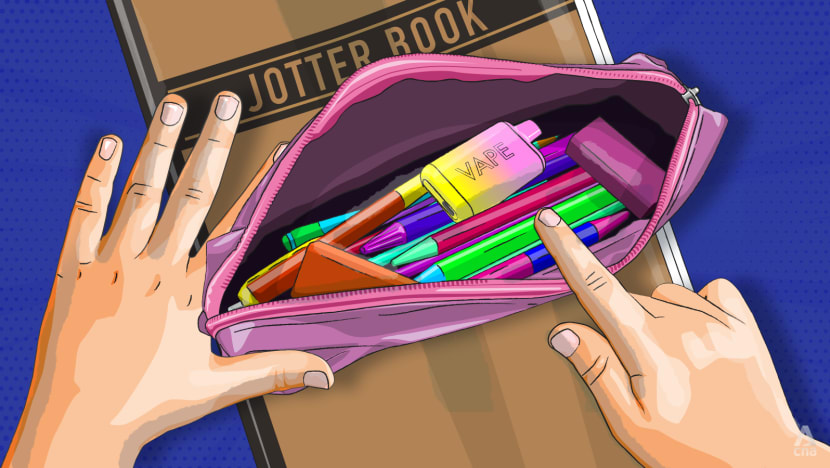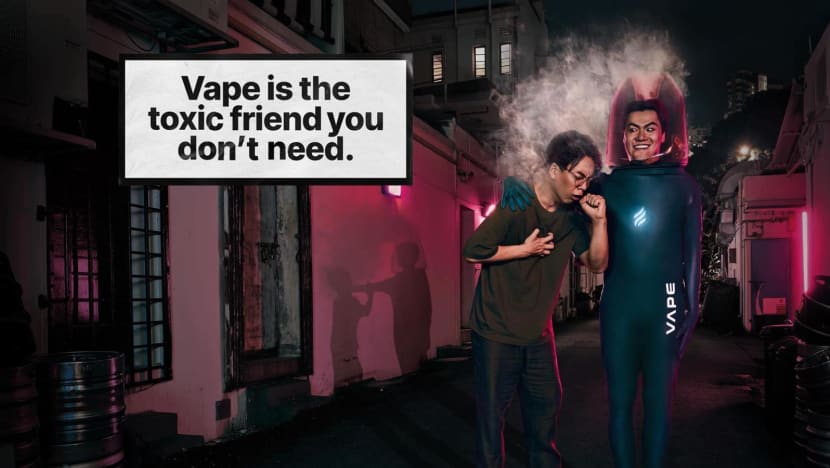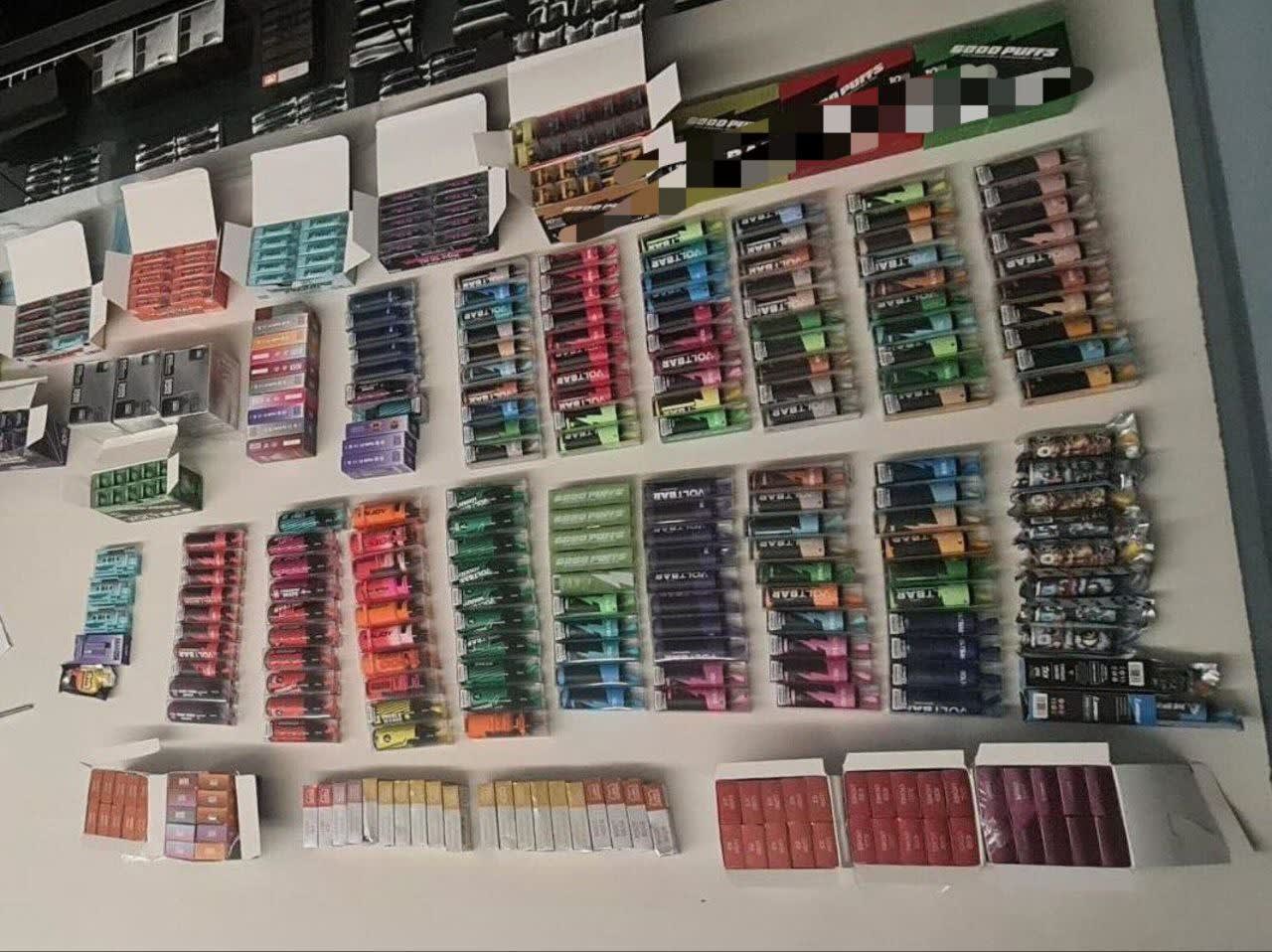IN FOCUS: How schools and families are combating the problem of vaping among children
With some youths starting to pick up vaping as early as primary school and with some vape sellers targeting young people, CNA looks at how schools and the authorities are fighting hard to tackle the issue.

With vapes easily available online or through friends, some students in primary schools are picking up the habit. (Illustration: CNA/Rafa Estrada)

This audio is generated by an AI tool.
- Despite vaping being illegal in Singapore, some school students have started picking up the habit
- Parents and school staff CNA spoke to expressed concern over the worrying trend, with schools stepping up measures to combat the problem
- Some groups have taken matters into their own hands, such as launching a vape amnesty programme
SINGAPORE: At one primary school, there is a poster outside every Primary 6 classroom that reads: Vape is the toxic friend you don’t need.
“My colleagues are panicking about (vaping), especially those who have children,” said Jane, a teacher at the school.
“Teachers are very concerned. But it’s a very hard thing to mitigate because kids have the capacity to hide it in their shoes, in different places. It’s very hard for the disciplinary committee to deal with it.”
Electronic vaporisers, commonly known as vapes, have made headlines in the past year, with teachers and parents telling CNA that those picking up the habit seem to be starting younger.
Vaping is illegal in Singapore and offenders can be fined up to S$2,000 (US$1,490). Those who import, distribute or sell such products face stiffer penalties, including a possible jail term.
On Nov 27, an 18-year-old was caught trying to sell a vape to a 13-year-old boy. Authorities received a tip-off that he had been seen selling vapes at a playground in Toa Payoh.
More than 700 vapes and related components with an estimated street value of S$15,400 were found during a search of the teenager’s home.
Last year, 800 students from schools and Institutes of Higher Learning (IHLs) were caught vaping and were referred to the Health Sciences Authority (HSA), Second Minister for Education Maliki Osman said in parliament in October.
Before 2020, the number of students referred to the Health Sciences Authority (HSA) for vaping offences was fewer than 50, he said, adding that vaping is likely an underdetected problem among students.
The names of the teachers and school staff members in this article have been changed as they are not authorised to speak to the media.

METAL DETECTORS
At a secondary school, some teachers have metal detectors to look for vapes.
Mary, a counsellor at the school, told CNA that vaping is an “overwhelming” problem. Once students are addicted, they skip lessons and look for places to vape together, such as toilets.
“Students being students, especially youths, they are quite smart. They will hide the vapes in (their) underwear ... in places where you can’t see unless you search.”
Teachers and school staff who spoke to CNA said they cannot search a student’s person. This has forced the secondary school to turn to metal detectors in the past year to help them find the vapes.
In another incident, a student from the secondary school posted a video on TikTok of her vaping with her classmate. This happened while the student’s mother was working from home.
When Mary phoned the student’s mother to inform her of the situation, she recalled the mother saying, “Oh, don’t worry. I’m working from home. I’ll monitor them.”
Parents may also be in denial when teachers notify them that their child has been caught vaping, said teachers and school staff.
In this case, Mary had to show the parent her daughter’s TikTok video to prove her point.
“Some parents (will say) ‘Why is vaping such a big issue? … So we have to explain to them that it’s illegal and you are not supposed to purchase it,” she said.
“But I think some of these parents are out of touch because they do see adults using vapes. They are kind of confused and sometimes they think that’s acceptable,” she added.
Cases of students being caught for vaping are not unique to this school. In a letter sent to parents and students of Queensway Secondary School, the Health Promotion Board (HPB) and HSA stressed that disciplinary action would be taken against anyone caught for vaping offences.
In bold and capital letters, the advisory read: “Vaping is illegal, regardless of age.”
“Vaping, just like smoking cigarettes, is harmful and can lead to lifelong addiction. E-cigarettes contain many harmful substances such as nicotine,” read the letter.
“These substances can negatively impact brain development, especially to parts of the brain that control attention, learning and memory.”
It warned that vapes also contain chemicals that can cause cancer and infertility, urging students to inform their schools if they know of someone who vapes or owns a vape.
Heart of the Matter podcast: Should vaping be regulated?
CONCERNS IN PRIMARY SCHOOLS
Claire, who was a teacher at a primary school until recently, recalled an incident where about 10 Primary 5 and Primary 6 students were hauled up in front of the entire school and shamed for vaping.
The students were all friends. One of the boys brought a bunch of disposable vapes to school and showed them to his friends, and the incident came to light when one of his friends reported it to a teacher, Claire said.
“Usually when that happens, the students will be under investigation and they end up exposing the rest of the culprits,” she added.
When the student was caught, he confessed that the vapes belonged to his parents, who had left them on the table at home. He saw the devices and decided to bring them to school to show his friends.
According to Claire, the student’s parents admitted that the vapes were theirs.
“I think because they’re still very young ... the school wants to settle it internally. Usually, it stays at (the school), we’ll just tell the parents and then come up with disciplinary action.”
Unlike cigarettes, vapes do not leave behind a heavy smoke smell. But non-smokers tend to be more sensitive to the smell – usually a fruity fragrance – of vape aerosols, said Mary.
To look out for students vaping in school, teachers have taken to making more rounds on campus, she added.
Sometimes, like in the case at Claire’s school, other students are the informants, telling teachers about their friends who are vaping.
DETENTION, SUSPENSION, CANING
Students are usually shocked when they are caught by school staff, said Mary. “But I think it is so addictive to them that it becomes a game of ‘catch me if you can’,” she added.
At the school where she works, those who are caught vaping for the first time will be issued a warning and their parents will be informed. Repeat offenders are given detention.
If and when they are caught, schools may refer students to a smoking cessation counsellor with HPB.
Schools are provided with guidelines – developed with HPB and HSA – to manage situations where students are found buying or using vapes, said the Ministry of Education (MOE) in response to CNA’s queries.
If a student is caught vaping, schools will inform their parents and confiscate the device. Teachers will also mete out the “appropriate disciplinary actions” such as suspension, or caning for boys.
These students are then referred to student health advisors or placed on HPB cessation programmes. Repeat offenders may be referred to HSA, which may issue them a fine, said MOE.
A WORRYING TREND FOR PARENTS
Parents of children in primary school were shocked and concerned upon learning that vaping is being seen among some primary school students.
One parent, who only wanted to be known as Mdm Tang, recalled when some students were found vaping in a toilet in her son’s primary school. One of them was friends with her older son, who is in Primary 6.
“I was quite shocked. I mean, this is a primary school. Plus the fact that I know the child personally. That was quite (shocking) to me,” said the 50-year-old, adding that she is concerned her sons might try vaping due to peer pressure.
“It is a worry for us … what they’re exposed to in school or outside. But at the same time, educating them is very important,” she continued.
Vaping is a worrying trend because it can spread easily among friends, said 49-year-old Ms Irma, who is a mother of five. Her youngest child is in Primary 6.
Her eldest son, who is 24, has friends who smoke and vape. Her younger son, who is 15, also has friends whose older siblings have tried vaping.
The issue comes up often at home, she added. Although Mdm Irma’s younger son and his friends do not vape, she is still concerned.
“I do not want them to get the idea that (vaping is) a glamorised version of smoking and therefore is not harmful,” she said.
“There's only so much that I can protect them (from) but beyond that when they go out, sometimes it's a little bit scary.”
Mr Sean Ang, a smoking cessation counsellor and pharmacist with Success Alliance Enrichment, said that in most of the cases that he encounters, the students are introduced to vaping through social media platforms and hear about it from their friends.
At such a “moldable” age, students in primary school and secondary school pick up habits easily, said Mr Ang.
| Year | Number caught using, possessing vapes |
| 2020 | 1,266 |
| 2021 | 4,697 |
| 2022 | 4,916 |
(Table: HSA)
GETTING HOLD OF VAPES
There have been cases of students who were caught vaping at the school Jane teaches at, although the identities of the students are kept a secret even among teachers to maintain the students’ privacy.
While she has not caught any of her students vaping, one student in the co-curricular activity she oversees was suspended after he was caught vaping outside school while in uniform.
At first, Jane was told that this student had to be suspended from the CCA for a set amount of time. When she asked him about what had happened, he was clearly embarrassed and took a while to admit that he had been caught vaping.
The boy, who was in Primary 6 at the time, got the device from his friends in secondary school, Jane shared. While the issue is prevalent among Primary 5 and Primary 6 students, those in lower primary mostly do not know what a vape is, she added.
Like in the case involving Jane’s student, most younger children get hold of vapes through their friends, said Mr Ang.
Vapes are easily available to young students both online and offline, he stressed, echoing what teachers shared with CNA when asked what made it most difficult to clamp down on vapes.
In November, a man was fined S$13,700 after hundreds of vapes and pods were found at his workplace at a Harvey Norman outlet in West Mall shopping centre.
He had been arrested in January after HSA officers received a tip-off about the sale of vapes to students in the area.

A quick search on messaging app Telegram turned up at least seven public groups, each having between 10,000 members and more than 50,000 members.
In these groups, individuals who are deemed as verified sellers send messages about what devices are available, instructions on how to order them and how much they cost. Some sellers go as far as to provide spreadsheets of the available flavours or an online order form.
Most of these sellers also request cash upon delivery only, stating that they do not accept digital payments as this might lead to them being identified.
These groups have existed for a few years. A CNA story in 2021 found that there were at least 10 vape chat groups targeted at Singaporeans on Telegram at the time, with a few thousand members each.
“There’s no regulation at all for all these platforms … On Telegram, you close one group and another one appears,” said Mr Ang.
Coupled with this ease of access, many younger students have the misconception that vaping is not harmful, or less harmful than cigarettes, Mr Ang said.
Aside from nicotine, there may be other harmful substances inside vape pods, but this cannot be controlled since vape products are not regulated, he added, stressing that nicotine is not safe for anyone of all ages.
Globally and locally, there is a rising trend in the use of vapes among youths, said the Ministry of Health (MOH) in response to queries from CNA.
Vapes typically contain nicotine, which is highly addictive and can "harm the developing brain of youths", noted MOH.
They also contain cancer-causing chemicals and other toxic substances, such as metal nanoparticles and particulate matter that increase the risk of lung and heart diseases.
"The toxic substances found in the heated aerosol produced by e-vaporisers can not only harm users but also others through second-hand exposure," added the ministry.
VOUCHERS IN EXCHANGE FOR VAPES
With the surge in the number of people caught vaping in Singapore, Mr Ang shared that individuals have started looking for help to quit vaping.
“Previously, they don’t come forward to ask for help. It’s always smoking cessation, and sometimes they come forward and say it’s smoking, but then you check and you realise it’s vaping.”
Since vaping in Singapore is illegal, this poses a big deterrent for them to come forward, he added.
There are currently no vaping cessation guidelines, but professional groups are trying to figure out how to tweak smoking cessation guidelines to tailor them for those who vape, said Mr Ang.
Other groups have taken things into their own hands. On Nov 18, the MacPherson Youth Network launched an anti-vaping campaign with Bilby Community Development, calling for youths aged 12 to 30 to surrender their vapes to receive a S$30 gift voucher for shops like Decathlon and Sephora.
They will face no penalty for handing in their vapes. The amnesty programme will run until Jan 2, 2024, covering the school holiday period.
In about two weeks, the team collected 46 devices from youths aged 12 to 35, said the vice-chairperson of the network Ng Shi Xuan.
The youngest person who turned over a vape was 12 years old, and the median age of those who did so was 19, he added.
The programme initially raised eyebrows online as people saw it as a way for the authorities to crack down on those who vape.
MacPherson Member of Parliament Tin Pei Ling told CNA that they worked with the authorities to waive the penalties for vaping for this specific programme.
“Obviously, there are people who are concerned whether there are people who are gaming this … because some of the devices can be quite cheap, and then they will game it just to get the vouchers. And there’s nothing stopping them from picking it up again later,” she said.
But the intention of the campaign is to raise awareness among youths, as they have to take a quiz about the legality and health risks of vaping when they turn in their devices, said Ms Tin.
“It’s also nudging them to take action to give up (vaping). It’s not going to magically happen overnight … But I think the idea is really wanting them to recognise the harms and take action,” she added.
“If this is going to make them think twice or three times harder the next time they even want to consider vaping, then at least I think we’ve made some inroads.”
In schools, teachers are provided with resources on how to prevent smoking and vaping, including “myths” about the habits. These resources also indicate how to support students in kicking the habit, and how to report cases to HSA where necessary, said MOE.
In Science lessons at the lower secondary level, students are taught about the harmful effects of substances found in tobacco products and the common myths about vaping, the ministry said.
Upper primary school students are also taught about how tobacco products affect a person’s health and fitness.
MOH urged parents to have "serious conversations" with their children about vaping to prevent it from becoming a lifelong habit. It also pointed to resources on its Parent Hub website.
Parents who are worried about their children picking up the habit should try to make sure that their children are comfortable talking to them about such issues, rather than worried about the repercussions, said Mr Ang.
They should try to understand what drove their children to pick up the habit. Habits like vaping are not only a sign of rebellion but a manifestation of other problems they are going through at home or in school.
“I would say be a part of the social support circle and work together with other people who are trained to help these kids let go of the habit.
“Be an avenue of support, rather than an avenue of fear,” he said.



















